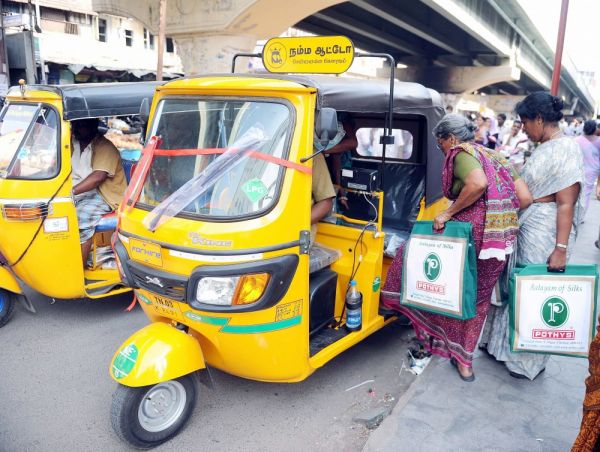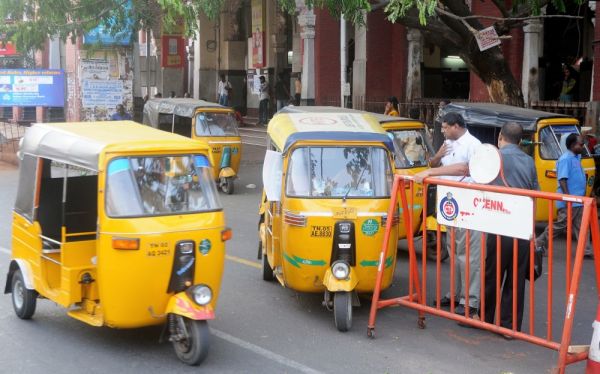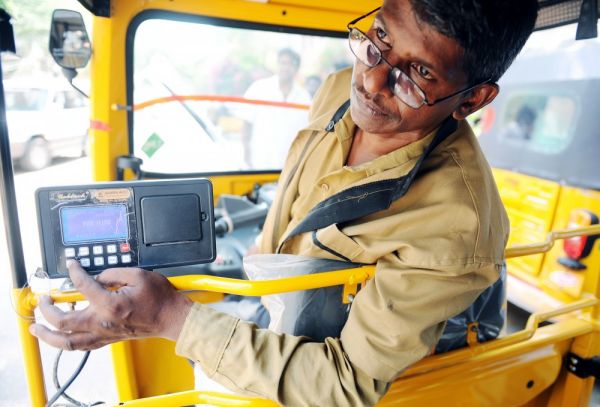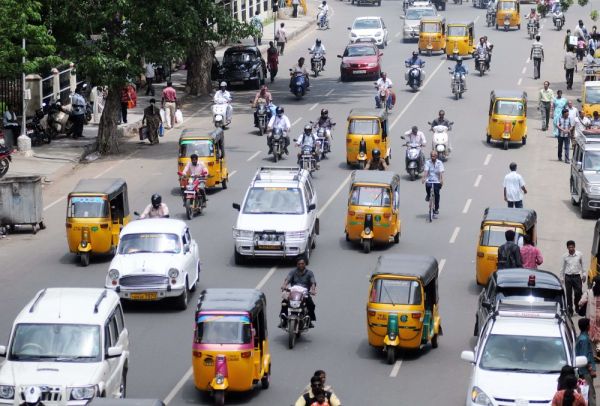Inept Regulation Leaves Autorickshaw Drivers and Passengers in a Jam

Shoppers board one of Chennai’s ubiquitous autorickshaws in the busy shopping district of T Nagar. Photo credit: B A Raju
I’m standing outside the Abiramapuram police station in Alwarpet, looking to hail an auto and get to Nungambakkam, a distance of about five kilometers.
Autos are Chennai’s equivalent of New York’s cabs — they’re ubiquitous, often the only option for last-mile connectivity, their drivers have attitude and they drive a bit recklessly to cross the city quickly. The pod-like cars are even yellow, albeit only three-wheeled. But unlike New York taxis, the Chennai auto system is a mess, both for passengers and drivers, thanks largely to inept government regulation.
The first auto draws up and we begin to haggle. Rs 120, says the driver. That’s a little more than $2 — if one goes by the official rate, the fare should be Rs 35 ($0.60). If the auto had a meter, that is. No one remembers seeing a meter in an auto in Chennai since the turn of the century. Since he’d probably laugh himself to death if I suggested 35, I say Rs 60 ($1). After some more haggling that involves him talking about rising petrol prices and the police’s penchant for making roads one way, we agree on Rs 90 ($1.6) largely because I’m in a hurry.

Haggling outside the Egmore railway station. Photo credit: A Prathap
Haggling with Chennai’s autodrivers is an art, and they are notorious for demanding ridiculously high fares. Most commuters are willing to pay more than the fares set by the state government since those were last revised in 2007.
“But auto drivers are unreasonable. Their rate for the last three kilometers from the Ambattur bus terminal to my house is far more than the I pay for the bus ticket to travel the 25 kilometers to my office,” says J Rajashekar, who takes a bus or a suburban train from Ambattur on the western edge of the city to get to his office in Nandanam in the south. He pays about Rs 15 ($.26) to take the bus to his office; an auto driver demands Rs 40 ($0.70) for the last three kilometers from the bus terminal to his house. “I walk, but when it rains or is too hot” – as is the case most of the time in Chennai – “I like to take an auto.”
In most cities, the minimum fare for a two-kilometer distance is between Rs 14 and Rs 16. In the absence of regulation, in Chennai it’s between Rs 30 and Rs 40, depending on the driver’s mood. In 2007, the state government set the fares at Rs 14 for the first two kilometers and Rs 6 for every subsequent kilometer. Despite the fact that fuel costs have risen about 25 percent since then, the fares have yet to be revised. The autos are supposed to have electronic meters, which were introduced in 2000, but most haven’t bothered to install them.
Overcharging has long been a problem in Chennai. In the 1990s and 2000s, the problem was that there were a limited number of autos since permits were tightly controlled by the government. Since the demand was greater than the supply, the rates were high. In 2010, the government lifted the freeze on issuing permits and reduced their cost. In a year, the number of autorickshaws more than doubled, from 30,000 to 62,000 across the state, most of them in Chennai. A recent count puts the number of permitted autos in Chennai at 66,769. At least another 15,000 run without permits, according to the auto unions.
“Earlier, only those who had passed Class 10 could get a permit. Now, most of the rules have been relaxed and a permit costs just Rs 375. Thousands of young men have got permits from the regional transport offices,” said M S Rajendran, president of Auto Drivers’ Welfare Association, which has 15,000 members.

The driver of a privately owned Namma auto switches on his meter. Photo credit: B A Raju
But if passengers seem to be getting the short end of the stick, drivers aren’t faring much better. A study released by Chennai City Connect, a non-profit that works on urban transportation issues, found that 35 percent of a driver’s daily running is “dead mileage,” i.e., driving without a passenger. The study pointed out other problems. “The lack of formal sources of credit has skewed the Chennai autorickshaw sector towards the rental system of driving, wherein the ratio of rented autorickshaw drivers to owner-cum-drivers stands at 7:3. Even when the autorickshaw is owned, the financial burden of paying almost double the interest rate (24 percent) to the moneylender, as compared to what would be paid to a bank (11.5 to 13 percent) weighs heavily on the driver… Only when drivers are relieved of the constant pressure of making payments will they feel a sense of ownership and freedom that is necessary to ensure smooth functioning of the system,” says the report.
It goes on to say that an autodriver earns about Rs 650 a day. But 70 percent of the drivers in Chennai rent their vehicles for Rs 150 to Rs 200 a day. Daily fuel costs amount to Rs 150, and maintenance about Rs 50 a day, leaving the average driver with earnings of about Rs 250 ($4.40) after a long day behind the wheel.
And the drivers themselves want regularized fares. “Our patronage would improve if the fares were standardized,” says Rajendran. Last year, the state transport department proposed Rs 20 as the minimum charge for a distance of two kilometers and Rs 10 for every extra kilometer in its revised autorickshaw fares. The unions have been demanding Rs 30 as the minimum fare and Rs 15 per kilometer thereafter. So the stalemate continues.
Two weeks ago, the Supreme Court in Delhi gave the Tamil Nadu government until July 6 to fix and implement a fare structure for autorickshaws.
In the meantime, private companies are beginning to fill the gap. Over the last few months, a couple of for-profit transportation firms have started offering auto services with meters and fixed fares. Namma Auto, a company started by two friends M Abdullah and Mansoor Ali Khan, put 17 autos on the road in mid May. The vehicles have tamper-proof electronic meters, and charge Rs 25 as the minimum for distances up to two kilometers and Rs 10 for every additional kilometer. “It’s higher than the government fare, but it’s reasonable and passengers are happy to pay it,” said Abdullah.
Its office in Teynampet is equipped with special software to track all its autorickshaws on a big screen. “All vehicles are equipped with GPS and GPRS tracking systems,” said Abdullah. “This allows us to track the location and speed of all autos.” The meters have printers that give passengers a receipt. Abdullah and Khan have plans to roll out 350 more autos by the end of the year.
The model offers a steady income to drivers and the chance to own the vehicles if they serve the company for three years. Drivers can choose to be paid a flat salary of up to Rs 18,000 a month, or opt for Rs 4,500 a month plus 30 percent of the fare money. Namma Auto driver Antony Raj says he often collects up to Rs 600 in fares in half a day, making five trips covering about 50 kilometers.
Drivers and their unions say they’re happy to see such initiatives, as they will benefit. “With a meter, a fixed fare and patronage, my income would definitely go up,” says S Kumaran, an auto driver from Padi.

When the government lifted a freeze on permits in 2010, the number of autos doubled within a year. Photo credit: A Prathap
But a regional transport official told The Times of India, an English daily, that they would have to take action against the company’s drivers since they would be charging more that the rates set by the government. In other words, a private company has succeeding in doing what the government has failed at, and is now being penalized for it despite its popularity in the market. The point may turn out to be moot: A police officer quoted by the newspaper says he and his colleagues will “turn a blind eye” to the company’s infractions because there was “an urgent need to revise fares and once that is done we will enforce them.”
Though it hasn’t had the will to rein in autos, the government is aware of the damage the autodrivers’ system is doing to the city’s image. It started a pre-paid auto system at the city’s main railway station in the early 2000s, which functions occasionally. In 2008, the state government introduced a fleet of tourist-friendly autos “to change the city’s auto culture.” The drivers were also to act as guides.
“We are known for our manners and our knowledge of the city,” says Samson, who drives one of the cream-colored cars with the words “tourist-friendly auto” emblazoned across it. He can usually be found outside the luxury Taj Coromandel Hotel or the high-end CIE art and craft showroom on Nungambakkam High Road, where visitors to the city often are. Samson even has his own website. “The busy months are from October to March, when tourists book me for the entire length of their stay. The rest of the year, I drive foreign business travelers around and some locals, too. The foreigners pay more, especially because we speak their language,” he says, smiling. “Merci beaucoup, cómo estás, ciao,” he rattles off. “It makes foreigners happy to hear it when they’re in a strange land.”
That might make tourists happy, but what locals would love is a set fare that drivers actually follow. Many drivers would like the same.









